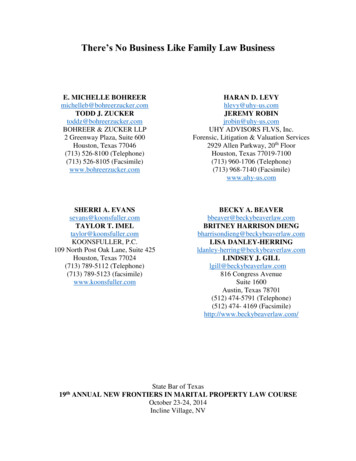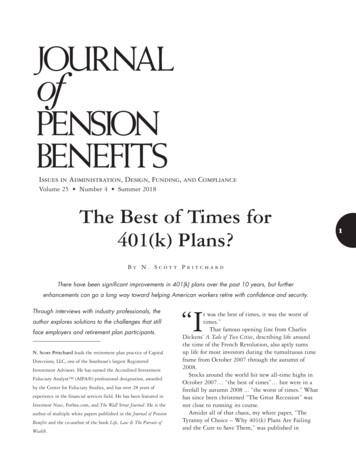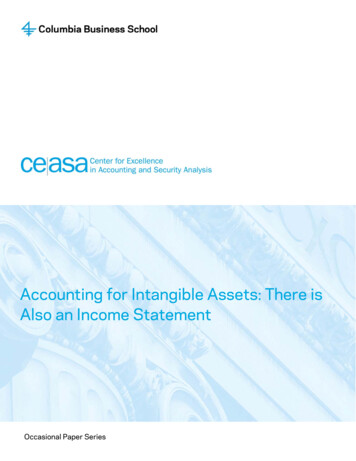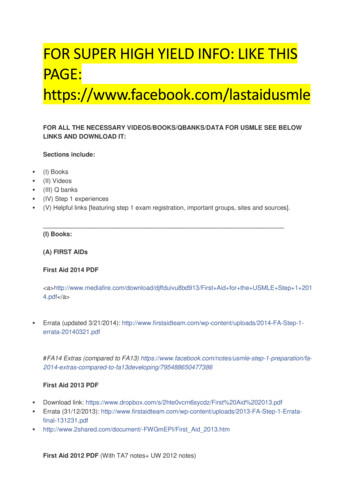
Transcription
There’s No Business Like Family Law BusinessE. MICHELLE BOHREERmichelleb@bohreerzucker.comTODD J. ZUCKERtoddz@bohreerzucker.comBOHREER & ZUCKER LLP2 Greenway Plaza, Suite 600Houston, Texas 77046(713) 526-8100 (Telephone)(713) 526-8105 (Facsimile)www.bohreerzucker.comHARAN D. LEVYhlevy@uhy-us.comJEREMY ROBINjrobin@uhy-us.comUHY ADVISORS FLVS, Inc.Forensic, Litigation & Valuation Services2929 Allen Parkway, 20th FloorHouston, Texas 77019-7100(713) 960-1706 (Telephone)(713) 968-7140 (Facsimile)www.uhy-us.comSHERRI A. EVANSsevans@koonsfuller.comTAYLOR T. IMELtaylor@koonsfuller.comKOONSFULLER, P.C.109 North Post Oak Lane, Suite 425Houston, Texas 77024(713) 789-5112 (Telephone)(713) 789-5123 (facsimile)www.koonsfuller.comBECKY A. BEAVERbbeaver@beckybeaverlaw.comBRITNEY HARRISON DIENGbharrisondieng@beckybeaverlaw.comLISA NDSEY J. GILLlgill@beckybeaverlaw.com816 Congress AvenueSuite 1600Austin, Texas 78701(512) 474-5791 (Telephone)(512) 474- 4169 (Facsimile)http://www.beckybeaverlaw.com/19thState Bar of TexasANNUAL NEW FRONTIERS IN MARITAL PROPERTY LAW COURSEOctober 23-24, 2014Incline Village, NV
TABLE OF CONTENTSI.II.III.IV.V.VI.Introduction .1Governing Law 1A. Generally .1B. Prior Law .1C. How TBOC Is Structured .2Formation .2A. Introduction .2B. Filing Entities .3Books, Records and Certificates .4A. Basic Record-Keeping Requirements .4B. Inspection .4C. Certificated or Uncertificated Ownership 4Overview of Forms of Businesses and Business Entities in Texas 4A. Sole Proprietorships .41. Generally 42. Formation and Organizational Documents 4B. Corporations .51. Generally 52. Formation and Organizational Documents 53. Issues Relating to Family Law. .6C. Limited Liability Companies 61. Generally 62. Formation and Organizational Documents 73. Issues Relating to Family Law. .7D. General Partnerships .71. Generally 72. Formation and Organizational Documents 83. Issues Relating to Family Law. 8E. Limited Partnerships .81. Generally 82. Formation and Organizational Documents .93. Issues Relating to Family Law. 9F. Limited Liability Partnerships. .9G. Professional Entities .9Marital Property Character Issues With Business Entities 10A. Characterization of the Business Entity .101. Inception of Title .102. Capital Contributions and Retained Earnings .113. Partnerships .114. Sole Proprietorship .125. Goodwill .12a. Business (Commercial) Goodwill .12b. Personal (Professional) Goodwill .12B. Characterizing the Individual Interest .131. Capitalization with Funds from Another Corporation .132. Acquiring Additional Interest in the Business .133. Redemption of Business Interests 13
VII.VIII.IX.X.XI.XII.XIII.4. Reissuance of Business Interests .13C. Characterizing Distributions .131. Dividends .142. Stock Splits .143. Liquidating Distribution . .144. Non-Liquidating Distribution. .14a. Mineral Rights Owned by a Partnership . .145. Distributions from Business Entities Held in Trust 15Business Mutations .17Insulation from Liability and Piercing .18A. Generally .181. Corporations .182. Limited Liability Companies .193. Partnerships and Limited Partnerships .19B. Piercing the Corporate Veil .201. Generally .202. Piercing is an Equitable Doctrine .203. Limited Partnerships May Not be Subject to Piercing .21Piercing the Corporate Veil in the Divorce Context .21A. No Unity Found .21B. Unity Found But No Harm .21C. Unity and Harm Found Beyond Remedy .22Potential Conceptual Problems with Reverse Piercing .22Valuation of the Business Entity .24A. Standard of Value – Fair Market Value .24B. Valuation Approaches 241. The Asset Approach .242. The Market Approach .243. The Income Approach .25a. Capitalization of Earnings Method .25b. Discounted Cash Flow Method .254. Reconciliation of the Three Approaches .25C. Adjustments to Financial Statements .251. Normalizing Adjustments 25a. Non-Recurring Expenses .26b. Non-Operating Income and Expenses .262. Control Adjustments 26a. Compensation Adjustments .26b. Debt-to-Equity Ratio .263. Other Financial Adjustments 26a. Capital Expenditures .27b. Fair Market Value of the Assets and Liabilities .27c. Related Party Transactions .27The Effect of Personal Goodwill in Valuing the Business Entity .27A. Single Owner Adjustment .27B. Multiple Partners Adjustment .28Control and Marketability Discounts 28A. Discount for Lack of Control .28B. Discount for Lack of Marketability 28C. Multiplicative vs. Additive .28
XIV.XV.Buy-Sell Agreements .28A. Overview .29B. Two Schools of Thought .291. One of Many Factors in Determining Value 29a. Keith v. Keith .29b. Von Hohn v. Von Hohn .292. Control the Value of Ownership .30a. Finn v. Finn .30b. Mandell v. Mandell .30Reimbursement claims .31A. The Jensen Claim 311. Overview .312. Elements of the Claim .323. Unsettled Issues .33B. Contributions of CP Funds to SP Business Entity .33C. Income Tax Liabilities on Undistributed Income from SP Entities 33D. Common Law Reimbursement Claims .331. Examples of Common Law Claims . 34a. Noncapital Improvements to Real Property .34b. Life Insurance Premiums .34c. Use of One Marital Estate’s Funds to Defend Litigation Regarding Another Marital Estate 352. Measurement of Reimbursement Claims 35a. Cost of Improvement .35b. Enhanced Value of the Improvement . .35c. The Lesser of Cost or Enhanced Value . .353. Stock Options: Separate Property Stock Options Exercised During the Marriage .364. Cash Calls: Using Community Funds to Maintain a Separate Property Investment .37
There’s No Business Like Family Law BusinessI.INTRODUCTIONII. GOVERNING LAWAccording to the U.S. Census released inDecember 2013, Texas added more than 387,000residents between July 1, 2012, and July 1, 2013, andmore than 1.3 million since April 1, 2010, significantlymore than any other state. Another significant statistic isthat small businesses, being those businesses with fewerthan 500 employees, numbered 2.2 million in Texas in2008. Of those, 391,010 were direct employers,accounting for 45.9% of private sector jobs in Texas andconstituting 98.6% of the state’s employers. Moreover,business ownership is becoming more inclusive inTexas. The number of women and minority ownedbusinesses in 2007 exceeded 700,000, an increase ofalmost 50% over 2002.1 Because small businesses are asignificant element of Texas’ economic landscape,family law practitioners frequently represent clientswho own or have a community property interest in asmall business.A. GenerallyThe Texas Business Organizations Code(“TBOC”) governs the following business entities:1.2.3.4.5.In 2003, the Texas Legislature enacted TBOC tocodify the Texas statutes relating to the above businessentities, together with the Texas statutes governing theformation and operation of other for-profit and nonprofit private sector entities.2 Prior to its enactment, noless than ten individual statutes governed businessentities in Texas. TBOC governs various formation,governance, operational and liability aspects of Texasbusiness entities, their owners or interest holders, andtheir principals.Family law practitioners need to understand thenature of the various business forms and entities, as wellas the issues relating to characterization of the businessentities. The importance of understanding the type ofbusiness entity, when and how it was formed, and anymutations of that entity are significant considerationswhen dividing the estate of the parties and determiningpotential equitable claims against the entity. In addition,organizational documents, such as partnershipagreements, bylaws, shareholder agreements andcompany agreements, may contain sale restrictions andbuy-sell provisions (which sometimes have divorcespecific provisions) and may affect the rights andobligations of the spouses in the context of a divorce.B. Prior LawTBOC was enacted in 2003, effective January 1,2006. As enacted, TBOC contained transitionprovisions that, generally speaking, provided for (1)TBOC to govern entities created or first registered on orafter January 1, 2006; (2) TBOC to govern entitiescreated or registered prior to January 1, 2006 upon theirelection to be governed by TBOC; and (3) TBOC togovern all entities, regardless of their date of creation orregistration or their election, on and after January 1,2010. The transition provisions are set forth in sections400.001, et seq. of TBOC.The involvement of a business law attorney andvaluation experts early in the divorce process cansignificantly improve a family law attorney’s ability toperform a proper analysis and provide competent andaccurate representation for his or her client. The purposeof this article is to assist family law attorneys inunderstanding (1) business entities, (2) the TexasBusiness Organizations Code and its relation to theFamily Code, (3) the effect of entity formation on maritalproperty character, (4) valuation of business entities inthe context of divorce and (5) reimbursement claims byone spouse against the separate property business of theother spouse.U.S. Small Business Administration, Office of Advocacy,Texas Small Business Profile (Feb. 2011).Corporations;Limited Liability Companies {“LLC”);General Partnerships;Limited Partnerships (“LP”); andLimited Liability Partnerships (“LLP”).Except as expressly provided in TBOC, all of theprovisions of TBOC govern acts, contracts or othertransactions by an entity subject to TBOC or itsmanagerial officials, owners or members that occur onor after the mandatory application date, and those acts,contracts or transactions that occurred prior to themandatory application date are governed by prior law.3Because TBOC became effective over four yearsago, this article will generally address TBOC rather thanprior law, although some specific issues relating to or1231Acts 2003, 78th Leg., ch. 182, Sec. 1, eff. Jan. 1, 2006.TBOC § 402.006.
There’s No Business Like Family Law Businessarising from prior law or the transition to the TBOC maybe addressed.TBOC section 1.002 provides the followingdefinitions:C. How TBOC is Structured1. “Corporation” means an entity governed as acorporation under Title 2 or 7. The term includes a forprofit corporation, nonprofit corporation, and aprofessional corporation.In a departure from the prior law, which had apatchwork of separate, self-contained statutes forspecific entities, TBOC was organized in a “hub-andspoke” format, which was designed to simplify andstreamline the statutory framework.2. “Limited liability company” means an entitygoverned as a limited liability company under Title 3 or7. The term includes a professional limited liabilitycompany.The “hub” is found in Title 1 (General Provisions),and contains provisions that govern all domestic entitiesand foreign entities to the extent provided in Title 1.4The subchapters within Title 1 govern matters such asformation, governance, required filings and liability,among others. These are found in Chapters 1 through12 of Title 1.3. “General partnership” means a partnershipgoverned as a general partnership under Chapter 152.The term includes a general partnership registered as alimited liability partnership.The “spokes” are found in other titles of TBOC andcontain provisions that apply to specific entity types.Thus, a practitioner analyzing issues involving aparticular type of entity should be familiar with both the“hub” provisions and any “spoke” provision applicableto that entity.4. “Limited partnership” means a partnership that isgoverned as a limited partnership under Title 4 and thathas one or more general partners and one or morelimited partners. The term includes a limited partnershipregistered as a limited liability limited partnership.5. “Limited liability partnership” means a partnershipgoverned as a limited liability partnership under Title 4.The spoke provisions that would typically comeinto play in the family law context include thefollowing:Note that TBOC does not apply to soleproprietorships, also called “DBAs” because thosebusinesses do not have a separate legal existenceindependent of their owners.1. Title 2 (Corporations), Chapters 20 (the GeneralProvisions sub-hub) and 21 (For-Profit Corporations);2. Title 3 (Limited Liability Companies), Chapter101 (same);III. FORMATIONA. Introduction3. Title 4 (Partnerships), including Chapter 151 (theGeneral Provisions sub-hub), Chapter 152 (GeneralPartnerships), Chapter 153 (Limited Partnership) andChapter 154 (Provisions Applicable to Both General andLimited Partnerships);TBOC governs the formation and internal affairs ofentities that are formed by filing the certificate offormation with the Texas Secretary of State, as well asa non-filing entity if Texas law is the law of the entity’sjurisdiction of formation.5 If the entity is formed byfiling a certification of formation or other similardocument with a foreign governmental authority, thelaw of the state or other jurisdiction in which thatforeign governmental entity is located governs theformation and internal affairs of the entity.6 TBOC alsoprovides that the law of the jurisdiction that governs anentity under the foregoing statutes also governs theliability of an owner, member, or managerial official ofthe entity in such person’s capacity as an owner,4. Title 5 (Real Estate Investment Trusts), Chapter200 (same); and5. Title 7 (Professional Entities), Chapters 301(Provisions Relating to Professional Entities), 302(Provisions relating to Professional Associations), 303(Provisions relating to Professional Corporations) andChapter 304 (Provisions Relating to ProfessionalLimited Liability Companies).45See TBOC § 1.106.See TBOC 1.101, 1.103.62See TBOC § 1.102.
There’s No Business Like Family Law Businessmember or managerial official, including a debt of theentity for which the person is not otherwise liable bycontract or under a provision of law other than TBOC.7Secretary of State’s filing system and assigning it a dateof filing; and (2) deliver a written acknowledgment offiling to the entity or its representative.12Entities that are formed by filing appropriatedocuments with the Texas Secretary of State are referredto as “filing entities.” Filing entities under TBOCinclude domestic corporations, limited partnerships,limited liability companies, professional associations,cooperatives and real estate investment trusts.8 Entitiesthat do not require filings, such as domestic generalpartnerships and nonprofit associations, 9 are referred toa “non-filing entities.”The existence of the filing entity commences whenthe certificate of formation takes effect as provided byChapter 4.13 The certificate of formation also mayspecify a delayed effective date, however, in which casethe certificate of formation would not take effect, andthe existence would not begin, until the specifieddelayed effective date.14 The requirements of theformation and of the determination of the existence of anon-filing entity are governed by the title of TBOC thatapplies to that specific entity.15Some types of entities have additionalsubcategories governed by special provisions thatdesignate or restrict the types of business in which theowners engage and may limit the liability of the owners,and these typically require additional documents to befiled with the Texas Secretary of State. There are alsosubcategories of some entities, such as a closecorporation or closely held corporation, which may playa role in how the entity is governed or valued, and othersubcategories that will insulate the interest holders fromliab
Houston, Texas 77024 (713) 789-5112 (Telephone) (713) 789-5123 (facsimile) www.koonsfuller.com HARAN D. LEVY hlevy@uhy-us.com JEREMY ROBIN jrobin@uhy-us.com UHY ADVISORS FLVS, Inc. Forensic, Litigation & Valuation Services 2929 Allen Parkw











